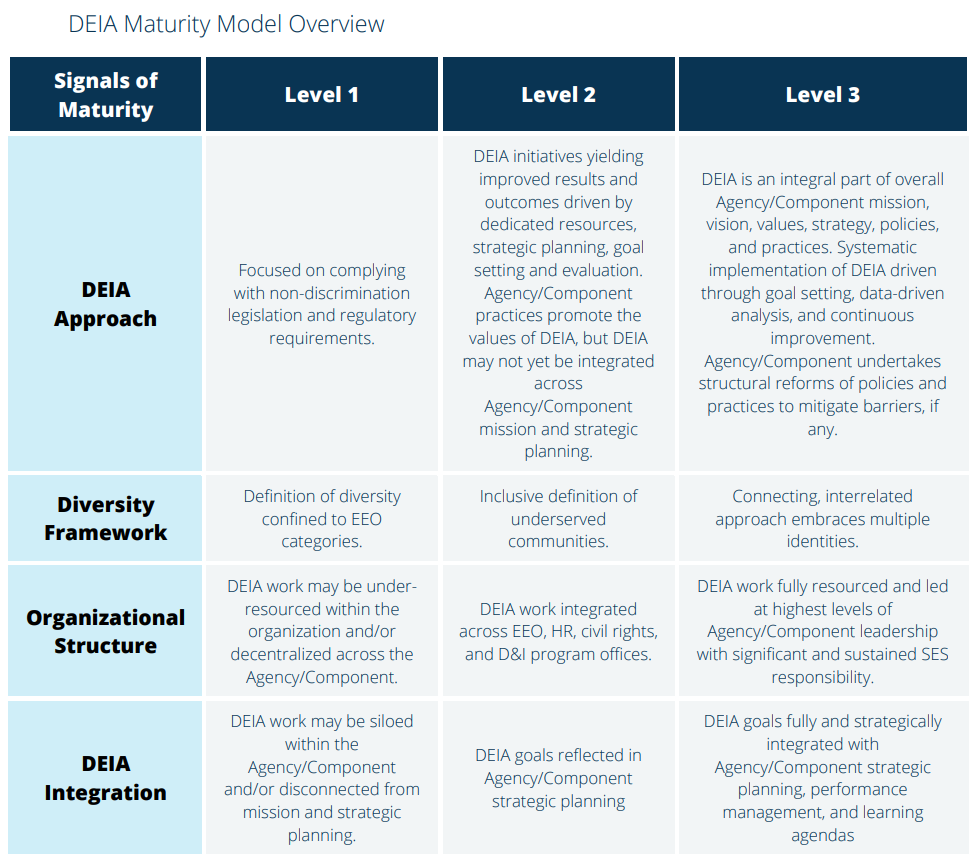OPM’s Underwood aims to help agencies reach next level of DEIA workforce goals
Among many DEIA priorities, OPM set a goal of increasing the new DEIA index in the Federal Employee Viewpoint Survey (FEVS) six points by fiscal 2026.
For the past few years, it’s been difficult to imagine any area of the federal workforce where the Biden administration isn’t trying to enhance diversity, equity, inclusion and accessibility (DEIA).
With the signing of a 2021 executive order, the administration tasked agencies with some hefty goals to improve DEIA. The order required agencies to integrate DEIA priorities into their recruitment, hiring, training, leadership development, employee pay and benefits and much more.
Eventually, the administration’s goal is to incorporate DEIA as an underlying and sustainable element of the federal workforce. But more than two years after the order’s enactment, some agencies are still working to advance past the early stages of compliance with the executive order.
Still, reaching the next level of DEIA necessitates first laying the groundwork. Janice Underwood, the first-ever governmentwide chief diversity officer and a senior leader at the Office of Personnel Management, said her role so far has involved helping agencies hire senior officials to lead agency-specific DEIA work, and setting targets in DEIA strategic plans.
“For the first time, the Biden administration has created this constituency in the federal workforce — the senior chief diversity officers who are trying to help agencies more robustly meet their missions, increase organizational health [and] increase employee experience,” Underwood said in an interview with Federal News Network. “The senior leaders are squarely focused on those outcomes.”
Underwood co-leads the Chief Diversity Officers Executive Council (CDOEC) alongside OPM Director Kiran Ahuja, Equal Employment Opportunity Commission Chairwoman Charlotte Burrows and Office of Management and Budget Deputy Director for Management Jason Miller. The council just celebrated its first anniversary last month.
Ultimately, the council’s goal is to bring together senior DEIA leaders across agencies to discuss goals and address challenges, Underwood said.
To take on that work, the council created four different DEIA working groups — standards; policy; data; and professional learning, training and outreach — and each has its own project plan. For example, the standards working group is in the process of drafting a standard position description for chief diversity officers, OPM said.
As part of the council’s work, agencies can participate in quarterly meetings, weekly working group meetings and an online learning community. Agencies can also attend office hours and request assistance from OPM’s DEIA office, Underwood said.
“We exist to help others — our customers are federal agencies,” Underwood said.
The objectives for DEIA stretch long-term, too. In its fiscal 2022-2026 strategic plan, OPM set a goal of increasing the new DEIA index in the Federal Employee Viewpoint Survey (FEVS) six points by fiscal 2026. The index, first featured in the 2022 FEVS, set the benchmark for measuring changes in federal employees’ perception of DEIA over time.
The 2022 DEIA index showed that 69% of federal employee respondents had positive perceptions of agencies’ DEIA practices.
For the next version of FEVS, Underwood said she will be closely following the data, which will be publicly released in the coming months.
“I’m on pins and needles,” she said. “I’m particularly interested to see if our composite score raises or lowers … As soon as those scores come out, I will get some indication on, ‘where do we press a little harder? Do we expend our attention to different areas? How do we need to pivot?’”
Within the DEIA index, OPM also asks FEVS respondents about each of the four individual categories of DEIA. In 2022, inclusion was the highest-performing section, with 75% positive responses, while equity was the lowest-performing section, with 65% positive responses.
“Equity was the score that the federal workforce battled with the most,” Underwood said. “[For the 2023 FEVS], that’s going to be the telltale sign of, ‘Have we been doing our job?’”
Underwood said one reason equity had a lower score may have been, in part, because it can be difficult to understand what equity looks like in the federal workforce.
The 2021 executive order on DEIA defined equity as “the consistent and systematic fair, just and impartial treatment of all individuals, including individuals who belong to underserved communities that have been denied such treatment.”
As an example, Underwood said part of the administration’s approach to advancing equity in the federal workforce ties back to the focus on early-career federal recruitment. Currently, less than 7% of the federal workforce is under age 30.
But as agencies try to build up their early-career talent, Underwood said there should be a focus on creating an equitable approach to recruitment that targets all candidates fairly.
One effort toward this end goal was OPM’s launch of an internship portal earlier this year. The portal lets agencies post current internship openings in one consolidated spot. A goal of that project is to reach more candidates from underserved communities, Underwood said.
“Now, you don’t have to go to every single federal agency to find internships,” Underwood said. “You can go directly to our internship portal and figure out, ‘are they paid? Are they unpaid? Are they remote? Are they in person? Are they hybrid?’”
The Biden administration also called on agencies to reduce their reliance on unpaid internships, which often precludes candidates who are unable to afford a high cost of living without receiving pay from an internship.
For agencies that are struggling with DEIA priorities, Underwood said OPM has a host of resources available to help agencies. For one, Underwood pointed to OPM guidance that aims to help agencies still struggling to hire a chief diversity officer.
“We know that everyone is situated differently and everyone has different challenges,” Underwood said. “We’re trying to meet those challenges and be honest about those challenges.”
And to try to help agencies track long-term goals, OPM created a “maturity model,” encompassing three distinct stages, that agencies can use to measure their progress in DEIA.

“Everyone might be starting in the compliance part of the maturity model, but we want them to move up to advanced, and we want them to move up to sustaining,” Underwood said. “Once we get up to that third stage, we need to start to partner agencies that are doing great things in one area, with other agencies who are struggling, and have some peer coaching.”
OPM is also developing a DEIA dashboard to offer agencies more data on their progress toward the administration’s priorities. Earlier this year, OPM conducted a pilot rollout of the dashboard, according to a September update on Performance.gov.
Following the pilot, that dashboard is now available to more agencies, Underwood said. But she’s hoping the data tool will eventually expand even further.
The dashboard “will improve as we iterate and add more questions that we want to ask and answer,” Underwood said. “It’s our hope that it will be available to all federal agencies in the coming years.”
Copyright © 2024 Federal News Network. All rights reserved. This website is not intended for users located within the European Economic Area.
Drew Friedman is a workforce, pay and benefits reporter for Federal News Network.
Follow @dfriedmanWFED






